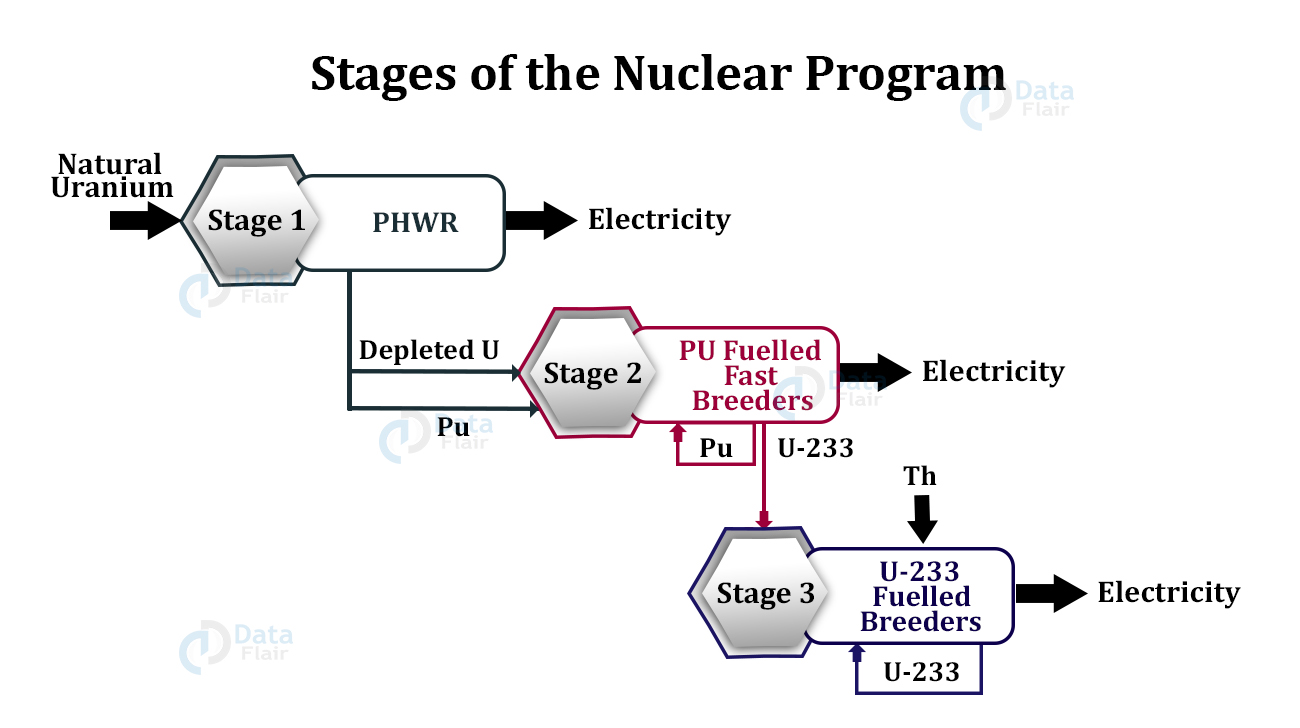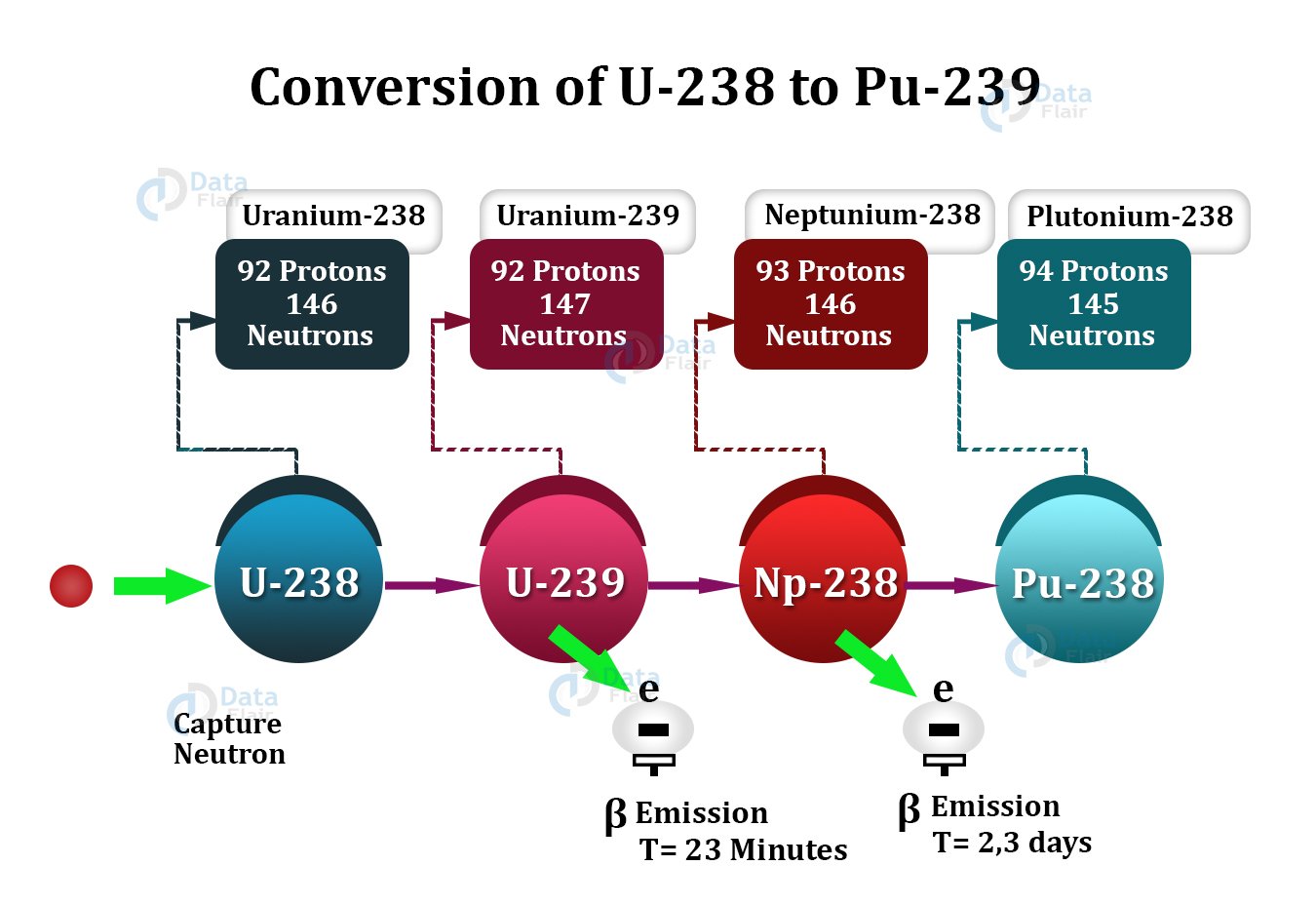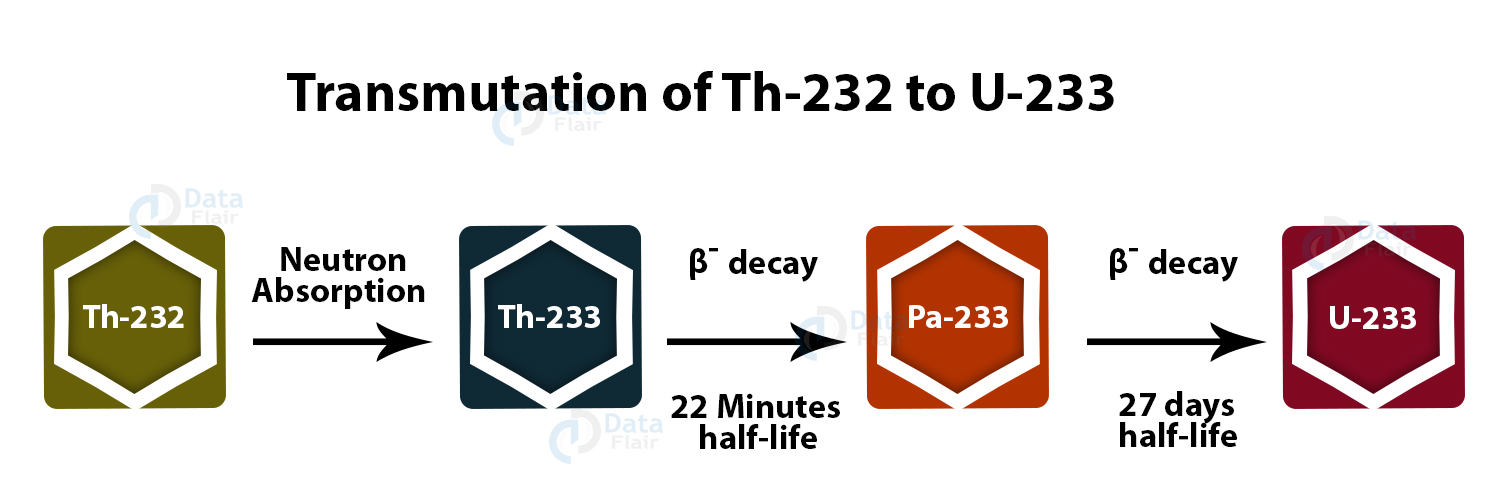India’s Three Stage Nuclear Power Program
Are you ready for UPSC Exam? Check your preparation with Free UPSC Mock Test
We all know how fast some energy resources like fossil fuels are being exhausted. So, in the wake of sustaining the future, it is imperative to explore some new methods of energy production. We are also aware of the importance of electricity and a nation’s economy.
So today, let us learn about something which is directly related to India’s electricity production and economy. Let us learn about India’s Three Stage Nuclear power Program.
Firstly, Why do we need Nuclear Power Plants?
Efficient energy production and management is the base of development of an economy. India accounts for more than 17% of the world’s population but only 6% in primary energy consumption. India’s per capita energy consumption is equal to one-third of the global average of per capita consumption.
In India, electricity production from non-nuclear thermal power plants accounts for 62%. These non-nuclear power plants run on coal, lignite, gas, and diesel. Whereas nuclear power plants account for only 2%.
Non-nuclear power plants cause a lot of pollution and their fuel is also depleting fast. Hence, the country needs to shift from non-nuclear power plants to nuclear power plants. Another good reason for the shift is that nuclear fuel amounts to the highest energy density in comparison to all its counterparts.
Nuclear Power Plants in India
Let us have a look at the Nuclear Power Plants in Indian which are in operation, under construction, and planned.
| Nuclear Power plants in Operation | Nuclear Power Plants under Construction | Planned Nuclear Power Plants |
| Rawatbhata (Rajasthan) Tarapur (Maharashtra) Kudankulam (Tamil Nadu) Kakrapar (Gujarat) Kalpakkam (Tamil Nadu) Narora (Uttar Pradesh) Kaiga (Karnataka) | Kakrapar 3&4 (Gujarat) Rawatbhata (Rajasthan) Kudankulam 3&4 (Tamil Nadu) KalpakkamPFBR (Tamil Nadu) | Jaitapur (Maharashtra) Kovvada (Andhra Pradesh) Mithi Virdi (Gujarat) Haripur (West Bengal) Gorakhpur (Haryana) Bhimpur (Madhya Pradesh) Mahi Banswara (Rajasthan) Kaiga (Karnataka) Chutka (Madhya Pradesh) Tarapur (Maharashtra) |
India’s Three Stage Nuclear Power Program
India’s three-stage nuclear power program is the brainchild of late H. J. Bhabha, informally known as, Father of Indian Nuclear Program. The eventual aim of the program is to properly utilize India’s vast Thorium reserves and to be self-reliant in nuclear energy production.
Objective Behind India’s Nuclear Power Program
- India has one of the biggest shares of worldwide Thorium reserves as opposed to a small share of worldwide Uranium reserves.
- But, Thorium is not a fissile material. Fissile material is the material that can sustain a nuclear chain reaction and produce energy.
But, it can breed another fissile material, U-233. U-233 is the most used nuclear fuel. - Breeding of U-233 and achieving a Thorium fuel cycle is not a one-step process, that is why India needs a three-stage program.
- So, the objective is to achieve the Thorium fuel cycle and be self-sufficient in meeting energy demands.
History Pertaining To The Program
Nuclear power plants were first developed in the early 1950s. Uranium has been the most widely used fuel for nuclear power plants until now. However, India has always been dependent on Uranium imports from other countries for its nuclear power programs.
So, a self-reliant method proposed by HJ Bhabha. This method would overcome the dependence on imports. And provide more efficiency in nuclear energy production. Four years later, in 1958, the Three Stage Nuclear Power Program was formally accepted by the Government of India.
Also, two years before the approval of the program, India’s first nuclear reactor, named APSARA, started its operation.
Stages of the Nuclear Program
Overview:
As the name suggests, the program consists of three stages. Electricity production takes place even in the intermediate stages. The three stages are –
1. Pressurized Heavy Water Reactor (PHWR)
2. Fast Breeder Reactor (FBR)
3. Thorium based Reactor
The above image shows an overview of the stages of the program.
Stage 1 – Pressurized Heavy Water Reactor (PHWR)
In the first stage of the program, the Pressurized Heavy Water Reactor fuel with natural Uranium.
Although natural Uranium contains only 0.7% of fissile Uranium, i.e., U-235, it does not mean that the other 99.3% of non-fissile Uranium, i.e., U-238 is a waste. Indeed, U-238 converts into another fissile material, i.e., Plutonium -239.
Conversion of U-238 to Pu-239 goes like this,
When we bombard a fast-moving neutron on U-238, U-238 becomes U-239. After that, U-239 rapidly converts itself to Neptunium-239 through beta decay. After that, Np-239 also undergoes beta decay and finally transmutes itself to Pu-239 in about 3 days. The below equation represents the above process.
In this process, Pu-239 generates a by-product, which will be used in the second stage of the program.
- Heavy water (D2O, Deuterium oxide) is used as both coolant and moderator in PHWRs.
- PHWRs are used in the program because they do not require enriched Uranium (3-5% of U-235) as opposed to Light Water Reactors, which require enriched Uranium.
- Although LWRs are more efficient, they are still not used in India because India does not have Uranium enrichment facilities. And buying or developing Uranium enrichment facilities is costlier than producing Heavy Water.
- The heat produced in the first stage is useful for electricity production
Stage 2 – Fast Breeder Reactor
In the second stage, a Fast Breeder Reactor is used. The Reactor fuels with Pu-239(generated in the first stage) and natural Uranium. Here, Pu-239 undergoes nuclear fission and produces energy. On the other hand, U-238 in natural Uranium transmutes itself to Pu-239.
- In this process, Pu-239, on average releases 2.3 neutrons for every neutron captured.
- Of these released neutrons, one neutron is used for maintaining the chain reaction, and one neutron captured by U-238 for transmuting itself to Pu-239.
- In this way, more and more Pu-239 produce.
- As the reactor produces more fuel (in the form of Pu-239) than it consumes, it is called “Breeder” Reactor.
- After its successful operation, once we have enough stockpile of Pu-239, Thorium will add as a reactant to form U-233. Here, Th-232 transmutes to U-233 which will be used in the third stage of the program.
- Transmutation of Th-232 to U-233 occurs as-
A neutron captured by Th-232 to become Th-233. Then Th-233 undergoes β- decay to form Protactinium-233 in just 22 minutes. After that, Pa-233 also undergoes another β- decay to produce U-233 in 27 days.
Stage 3 – Thorium Based Reactor
The Third stage reactor is not yet built although technology is readily available. In the third stage, the reactor will attain a self-sustaining nuclear fuel cycle. This reactor would be a thermal breeder reactor, which can be refueled using Thorium alone, after its initial fuel charge.
In this stage, a combination of U-233 and Th-232 will be used as fuel. After that, a proper fuel cycle will achieve as shown below.
Uranium undergoes fission and produces energy. Stray neutrons released from fission will hit Th-233 and Th-233 will be transmuted to U-233. Now, the transmuted U-233 will again undergo fission with the production of energy and stray neutrons and the cycle will be built.
- As per the government, Large scale installation of Thorium based Reactors would be possible after 3-4 decades of the second stage. The second stage includes the commercial and viable operation of Fast Breeder Reactors.
- As most of the Thorium is useful in the later stage, India is finding some other ways in parallel to the program to utilize its Thorium reserves.
- Three options are being considered for the parallel use of Thorium utilization, namely,
- Indian Accelerator Driven Systems (IADS)
- Advanced Heavy Water Reactor (AHWR)
- Compact High-Temperature Reactor
- Among these options, AHWR is fully prepared to install. Although the technology is available for many years still there are no signs of construction of any AHWR in the country.
The other two technologies are still under research and development phases.
Present Status and Future aspect of the Program
- Presently, India is in the second stage of the program.
- India is building its first Prototype Fast Breeder Reactor at Madras Atomic Power Station in Kalpakkam, Tamil Nadu. Let us learn about it.
India’s Prototype Fast Breeder Reactor at Kalpakkam
- The capacity of the reactor is 500 MWe.
- Indira Gandhi Centre for Atomic Research (IGCAR) is the designer of the reactor.
- Although the construction is over, it has not got the clearance from the Atomic Energy Regulatory Board (AERB) to operationalize the reactor.
- The reactor will use U-238 to breed new fissile material.
- The surplus U-238 (which also transmutes to Plutonium) will be helpful to set up more such reactors and meet India’s growing power demand.
- The reactor will cool by liquid Sodium. Sodium raises safety concerns because it burns in the presence of air and explodes in contact with water.
- The project is continuously facing delays, starting from 2010. Now if everything goes as per plan, it will achieve its criticality in 2021.
- Along with this PFBR, four FBRs have been approved.
- But still, India requires a lot of FBRs and an estimated 4 more decades to build a stockpile enough to fuel the third stage of the program.
Challenges
- The Challenge in achieving the target of the program does not lie in technology but in the limited quantity of available Uranium fuel, because this would be used to convert fertile Thorium into fissile U-233.
- India has even tested all the technologies related to the program in the laboratories but does not have enough fissile material.
- Even after completion of the program, challenges like maintenance, preventing unwanted accidents, disposal of nuclear waste remains. Although with the advancement of technology, these challenges can take care of up to a large extent.
- Land acquisition and finding the appropriate locations could also be a challenging task for the government.
Overcoming India’s Fissile Material Shortage
- The best option for India is to procure Plutonium from other countries. Plutonium is also a fissile material.
- As of now, there is not much trade of Plutonium in the international arena. No law forbids the trade but still, there is not much trade.
- Most of the nuclear treaties cover only U-233 and U-235.
- The Non-Proliferation Treaty mandates the transfer of fissionable material to be under safeguards. This also includes the transfer of Plutonium.
- But still, the process is not as complicated as the transfer of Uranium.
- There are countries such as Japan and the UK, which want to reduce their Plutonium stockpile. These countries will be happy to sell their stockpile to India.
Obstacles in procuring Plutonium
- The only obstacle in the Plutonium trade could be the United States.
- Although, no treaty bans the trade of Plutonium. But still, the US can become an obstacle by putting sanctions, reducing scientific cooperation, etc.
- Convincing the United States will certainly result in obstacle-free trade.
What Follows Next?
India is certainly a leader in Thorium research and at the later stages of the program. It is the only country with this much detailed program having approval and funding by the government. India currently envisages meeting 30% of electricity demand through Thorium by 2050.
And the time when India achieved its target, India would become energy independent, also giving a huge boost to the Indian economy. India would also be in a stage to dominate the nuclear energy market due to large Thorium reserves and advanced technology.
Conclusion
In the above article, we learned about the importance of Nuclear energy and India’s Three Stage Nuclear Power Program. We specifically discussed all the stages of the program in detail.
We learned about the vision and the plan of the country to utilize its vast Thorium reserves and achieve energy independence.
Along with this, we also learned about the present status and future aspect of the program, challenges pertaining to its successful implementation, and the energy-independent future of the nation.
Your 15 seconds will encourage us to work even harder
Please share your happy experience on Google








